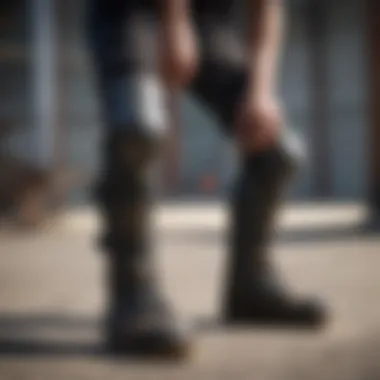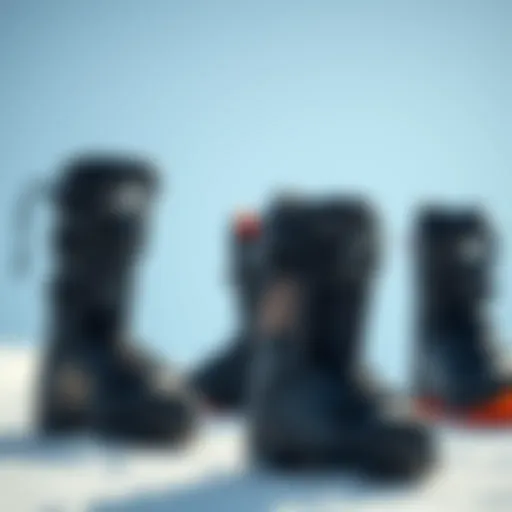Youth Knee Pads: Essential for Skateboarding Safety


Intro
Skateboarding as a sport encourages creativity, skill, and expression. Yet, it also carries risks, particularly for the youth who are eager to explore their limits. Youth knee pads are pivotal in this context. They provide a layer of protection that can significantly reduce the risk of injury. This article aims to elucidate the multifaceted role of knee pads in enhancing safety and performance for young skateboarders. Understanding how to choose the right knee pads, their proper use, and maintenance practices is essential for any youth involved in the sport.
Techniques and Tips
Skill Development
Knee pads can influence the learning curve for young skateboarders. By offering protection, they allow youth to practice their skills with less fear of injury. This confidence leads to skill development as skateboarders feel free to attempt new tricks or navigate challenging terrain. A strong understanding of fundamental techniques enhances their overall performance. Practice becomes less about maintaining caution and more about refining agility and style.
Practical Techniques
Using knee pads correctly is essential to gain their full benefits. Here are some techniques that can enhance their protective features:
- Ensure a snug fit: Knee pads should be tight enough to stay in place but loose enough to permit movement.
- Positioning: Correct placement over the knee cap can prevent slippage or displacement during falls.
- Maintenance: Regularly inspect knee pads for wear and tear. Keeping them clean maximizes comfort and usability.
Common Mistakes to Avoid
Many young skateboarders overlook the importance of proper fitting gear. Common pitfalls include:
- Using oversized pads: Loose pads can shift during falls, offering inadequate protection.
- Neglecting other gear: Focusing solely on knee pads while forgetting elbow or wrist pads can lead to injuries in those areas.
- Inadequate replacement: Continuing to use worn-out pads decreases safety. Always replace damaged pads promptly.
Gear and Equipment
Essential Gear for Beginners
For beginners, the right equipment is crucial for safety. Besides knee pads, skateboarding gear includes:
- Helmet: Protects the head from potential impact.
- Elbow and wrist guards: Safeguard against falls that can lead to fractures or sprains.
- Skate shoes: Designed for optimal grip and support.
Latest Innovations and Trends
The market for protective gear has evolved. New technologies and materials offer better protection and comfort. Brands now offer knee pads designed with lightweight materials, offering enhanced breathability. Look for options that include adjustable straps for personalization. Some innovative products incorporate moisture-wicking fabrics to keep the skin dry during intense sessions.
Reviews and Comparisons
When selecting knee pads, understanding product offerings is essential. A few reputable brands such as Pro-Tec, 187 Killer Pads, and Triple Eight have garnered positive reviews. Users appreciate the balance of protection and mobility these pads provide. Researching and comparing models before a purchase can ensure that young skateboarders are investing wisely in their safety.
Safety Measures
Essential Safety Gear
In addition to knee pads, comprehensive safety gear is a fundamental component of skateboarding. Essential items include:
- High-quality helmet
- Elbow and wrist guards
- Proper fitting skate shoes
- Comfortable clothing: Loose-fit clothes can get caught during tricks, leading to falls.
Best Practices for Safe Participation
Safety is not just about wearing protective gear. It involves practices such as:
- Data Tracking: Keep track of improvement and areas that need work to avoid overexertion.
- Warm-up exercises: Stretch before riding to reduce the risk of muscle strains.
- Community Engagement: Participating in local skateboarding events can enhance skill through collective learning.
Injury Prevention and Management
Accidents can still happen, even with precautions in place. Being prepared for potential injuries is critical. Basic first-aid knowledge can aid in immediate response when necessary. Having ice packs, bandages, and antiseptic available during practice sessions can help manage minor injuries promptly.
"Investing in quality knee pads is investing in the long-term wellness of young skateboarders. A safe skater is a confident skater."
Culmination
In summary, youth knee pads play a crucial role in the safe practice of skateboarding. Understanding their value, how to use them effectively, and staying abreast of innovative gear can significantly impact a young skater’s experience. Protection should never be an afterthought but a core aspect of skateboarding, allowing youth to enjoy the sport while minimizing risks.
Prelims to Youth Skateboarding
As skateboarding continues to gain momentum, its presence in youth culture has become markedly significant. Children and teenagers across the globe have gravitated towards skateboarding not just as a sport, but as a form of self-expression and social interaction. This rise presents important considerations not only about the sport itself but also about safety, especially in the realm of protective gear.
The importance of understanding youth skateboarding lies in acknowledging the blend of thrill and risk that accompanies it. Young skaters, in their quest for adventure, often underestimate the potential for injuries. By discussing the relevance of proper safety gear, particularly knee pads, we emphasize how these products play a crucial role in ensuring the safety of aspiring skateboarders. Furthermore, we can foster a culture of protection and caution while enjoying this exhilarating activity.
Skateboarding enhances physical coordination and provides various psychological benefits like confidence and resilience. However, these benefits come with the reality that falls and injuries are commonplace. Therefore, this section sets the stage for our exploration of knee pads as essential items that not only provide protection but also empower youth to enjoy skateboarding without the constant fear of injury.
The Rise of Skateboarding Among Youth


Skateboarding's popularity among the young is unmistakable. Factors contributing to this phenomenon include social media influences, online skate videos, and a vibrant community that welcomes newcomers. In many urban areas, skate parks become social hubs where new skaters learn from experienced ones. Moreover, brands that sponsor skateboarding events have made it more accessible and appealing, drawing even more youth into the fold.
This surge has sparked interest in various skateboarding styles, from street to vert, accentuating the need for specialized protective gear. Youth are now more likely than ever to incorporate skateboarding into their daily lives, making knowledge about protective equipment crucial for parents, guardians, and skate enthusiasts alike.
The Importance of Safety in Extreme Sports
Extreme sports like skateboarding inherently carry risks due to their nature. Injuries can range from minor scrapes to serious damage requiring medical attention. This reality makes safety practices non-negotiable. While thrill-seekers often chase adrenaline, the acute dangers involved underline the need for effective safety measures.
Using protective gear such as kneepads helps mitigate injury risks. Young skateboarders are particularly vulnerable due to their developing bodies and lack of experience, making it essential for them to wear the right gear.
"Studies indicate that consistent use of knee protection reduces the incidence of injuries significantly among youth skaters."
To enhance awareness of the critical nature of safety gear, educating youth about the effectiveness of knee pads can aid them in understanding that taking precautions does not diminish the thrill of skateboarding. Instead, it enriches their experience by allowing them to focus on their skills and pushes them to advance without the anxiety of frequent injuries.
Understanding Knee Pads
Knee pads play a crucial role in the realm of youth skateboarding. They serve as a barrier between the body and the hard surfaces that skateboarders frequently encounter. Understanding knee pads involves looking at their purpose, construction, and benefits. It is essential to grasp how knee pads contribute to safety and performance, especially among young skateboarders who are more vulnerable to injuries. As youth skateboarding grows in popularity, the importance of equipping young riders with appropriate protective gear cannot be overstated.
What Are Knee Pads?
Knee pads are protective gear designed to cushion and shield the knees from impacts and abrasions. They typically consist of a padded cover that encases the knee joint, providing support during falls or sudden movements. Most knee pads feature an inner foam lining to absorb shock and an outer layer made of durable material. This design helps to distribute the force of an impact, lowering the risk of injury. For youth skateboarders, knee pads act as a safety net, allowing them to practice tricks and explore their skills without excessive fear of injury.
Materials Used in Knee Pads
The effectiveness of knee pads is largely determined by the materials used in their construction. Common materials include:
- EVA Foam: This is a lightweight yet effective shock-absorbing material that is often used in the inner cushioning of knee pads.
- Polyester or Nylon: These durable fabrics protect the outer layer of knee pads, ensuring they can withstand scrapes and impacts.
- Polycarbonate: This material is frequently used in hard shell knee pads for additional protection. It resists impact well, making it suitable for extreme sports.
Different combinations of these materials impact the overall performance of knee pads. Youth should consider knee pads made from high-quality materials that offer the best balance between comfort and safety.
Understanding the construction and materials of knee pads can greatly enhance their efficiency in protecting youth skateboarders.
Having knee pads with the right materials can make a significant difference in preventing injuries, allowing young skaters to focus on improving their skills.
Types of Knee Pads for Skateboarding
Understanding the types of knee pads available is crucial for youth skateboarders. Choosing the correct type can significantly affect both safety and performance. Youth skateboarding involves many falls and impacts, making effective padding essential. Moreover, different types offer unique benefits that can cater to specific riding styles and preferences.
Hard Shell vs. Soft Shell Knee Pads
Knee pads generally come in two designs: hard shell and soft shell. Each has its own advantages and considerations.
Hard shell knee pads feature a rigid outer layer designed to absorb impacts from falls. This type is ideal for aggressive skating or when performing tricks. The hard-shell construction prevents serious injuries by dispersing shock over a broader area. However, they limit flexibility and can be bulkier, which might impair movement.
In contrast, soft shell knee pads are made with thicker foam and fabric. They focus on comfort and mobility, providing adequate cushioning without restricting movement. Soft shell pads are generally lighter and less cumbersome, making them suitable for casual skateboarding or beginners. But they may not offer the same level of protection against high-impact falls.
Each skater should consider their personal needs and usages before selecting a type. While a more serious athlete may prioritize protection, a beginner might find comfort more appealing.
Impact Resistance Ratings
Impact resistance ratings play a central role in understanding how effective knee pads will be in protecting against injuries. These ratings are determined through standardized tests that measure how well the pads can absorb forces during impacts. Generally, higher ratings indicate better protection.
When assessing knee pads, it is advisable to look for certifications from recognized safety standards organizations. Whether the pads are certified by organizations like ASTM or CE can greatly influence their reliability. Understanding the ratings allows skaters to make informed choices based on their skill levels and the types of challenges they expect to face.
In summary, selecting the right kind of knee pads is a balance between protection, comfort, and personal skateboarding style. Evaluating hard shell versus soft shell models and being aware of impact resistance ratings will ensure that young skateboarders are properly equipped to handle their rides.
Choosing the Right Knee Pads
Choosing the right knee pads is a vital step for youth skateboarders who prioritize safety. Proper knee pads can substantially reduce the risk of injury. Skateboarding is an inherently risky sport. Young enthusiasts often push their limits in search of thrill. Thus, having adequate protective gear becomes essential. Without appropriate knee pads, young skateboarders may find themselves in vulnerable situations.
Several elements must be considered when selecting knee pads. The fit, material, and design influence not only safety but also comfort during skateboarding. Choosing the right size ensures that the pads stay in place when they are needed most. Additionally, the adjustability features can enhance the fit, allowing for a more personalized experience that caters to the unique needs of the individual.
When youth skateboarders use well-fitted knee pads, they experience better mobility and less distraction. This can lead to improved focus on their skating technique. Therefore, the decision on which knee pads to use should never be taken lightly.
Fit and Size Considerations
Fit and size are fundamental aspects of knee pads that directly affect their performance in protecting against injuries. The correct size ensures that the knee pads cover the vulnerable areas of the knees while allowing for freedom of movement. Poorly fitting knee pads can slip down or become uncomfortable, which may lead to their removal during use.
When trying on knee pads, it is crucial to test their fit while engaging in a few skating maneuvers. This helps in assessing how well they stay in place.
Key factors to ensure proper fit include:
- Measurement: It is important to measure the circumference of the knee. This is done by using a flexible tape measure around the area just above the kneecap.
- Sizing Charts: Many manufacturers provide sizing charts. These charts can guide users based on the measurements taken.
- Straps and Fastenings: Knee pads often come with adjustable straps. These can help secure the pads firmly against the knee, reducing the likelihood of them shifting out of place.


A snug fit should balance comfort and security without feeling restrictive. This is key in maximizing both safety and performance.
Adjustability Features
Adjustability features in knee pads can significantly enhance their effectiveness. These features allow for customization to fit various leg shapes and sizes. Knee pads equipped with adjustable straps, Velcro closures, or elastic bands enable wearers to modify the fit according to their personal comfort and activity level.
Some noteworthy adjustability features include:
- Strap Systems: Multiple strap systems provide a more tailored fit. This prevents any movement during tricks or falls.
- Expandable Design: Knee pads with expandable sections offer flexibility. This is particularly helpful as the wearer's level of experience and skills grow over time.
- Easy Adjustments: Look for knee pads that allow for quick adjustments. Features that simplify this process mean that youth skateboarders can make changes on the fly without hassle.
Investing in knee pads with these adjustability features not only promotes comfort but boosts confidence when skating. In a sport filled with risks, the assurance that protective gear fits properly can make all the difference.
The Importance of Proper Use
Using knee pads correctly is crucial for maximizing their protective benefits and ensuring safety while skateboarding. Many young skateboarders may underestimate the importance of wearing knee pads properly or may not know how to use them effectively. Yet, the difference between proper usage and careless application can significantly affect safety outcomes in the event of a fall or collision.
Correct use of knee pads not only mitigates the chance of knee injuries but also enhances the feel and functionality of the gear. When worn correctly, knee pads can help stabilize the knee joint, reducing strain and providing support during intense maneuvers. Additionally, proper use creates a sense of security that allows skateboarders to push their limits without the constant fear of severe injury. This can foster skill development and encourage the adoption of more advanced techniques, ultimately enhancing the overall skateboarding experience.
How to Wear Knee Pads Correctly
Wearing knee pads correctly involves a few straightforward steps:
- Positioning: Place the knee pad over the knee joint, ensuring it covers the kneecap completely. The pad should sit snugly without hindering movement.
- Securing Straps: Adjust the straps to secure the knee pads in place. They should be tight enough to prevent slipping but not so tight that they restrict blood flow.
- Testing Mobility: After securing them, perform a few knee bends or other movements to test comfort and fit. The knee pads should feel secure yet allow for complete range of motion.
Frequent checks and adjustments before or during a session are also important, especially as movement can often shift the knee pads out of place.
Common Mistakes When Using Knee Pads
Many skateboarders make mistakes when applying knee pads that can compromise their protective qualities. Here are some common errors to avoid:
- Incorrect Positioning: Not centering the knee pad over the kneecap can expose vulnerable areas. Ensure the pad is aligned correctly.
- Overly Loose or Tight Fit: Knee pads that are too loose can slide down, while those that are too tight can cause discomfort. Finding the right balance is key.
- Neglecting Regular Checks: Failing to check the knee pads before every skate session can result in unexpected slips during a ride.
- Using Damaged Knee Pads: Skateboarders should always inspect their knee pads for signs of wear or damage. Worn-out pads lose protective qualities.
Proper use of knee pads greatly reduces the risk of knee injuries and can enhance a skateboarder's confidence in their abilities.
By being mindful of these common mistakes and understanding how to wear knee pads properly, youth skateboarders not only protect themselves but also prepare to enjoy their skateboarding journey fully.
Impact of Knee Pads on Skateboarding Performance
The use of knee pads plays a critical role in skateboarding performance, especially for young skateboarding enthusiasts. The significance of wearing these protective gears extends beyond mere injury prevention. Knee pads can profoundly affect the confidence and skill development of riders.
Improving Confidence While Riding
Confidence is a fundamental aspect of performing well in skateboarding. When young riders wear knee pads, they often feel a sense of security. This protection allows them to push their limits without fear of severe injuries. The knowledge that their knees are safeguarded can lead to greater willingness to try new tricks or techniques.
For instance, when a skater attempts a trick that involves landing on their knees, padded protection provides essential cushioning. This can transform the rider's attitude towards risk. As their comfort level increases, so does their ability to focus on the mechanics of their skateboard moves rather than worrying about possible injuries. This shift in mindset is crucial for any athlete looking to enhance performance.
Effects on Skill Development
The impact of knee pads goes hand in hand with skill enhancement. As confidence builds, skaters become more adventurous with their skating. They start tackling challenges that, without knee pads, might seem daunting or risky. This exploration is vital for acquiring new skills.
Additionally, because the knees are a primary point of contact during falls or challenging landings, protecting them allows for practice without the added concern of injury. This leads to an important cycle: the more skaters practice, the better they become. The use of knee pads allows them to engage in consistent practice, reducing downtime due to injuries.
In summary, knee pads do not only serve as a basic safety tool; their benefits reach far beyond. They instill confidence in riders and facilitate skill development. From young beginners to seasoned skateboarders, the right protective gear can significantly influence the trajectory of their skating journey.
"With knee pads, I feel ready to tackle any ramp or trick. It's like a safety blanket for my knees, allowing me to really go for it."
Knee pads matter not just for safety, but for enhancing the overall skateboarding experience.
Cultural Perspectives on Knee Pads in Skateboarding
The perception of safety gear, like knee pads, within the skateboarding community has evolved significantly over the years. Skateboarding, often associated with rebellion and self-expression, initially viewed protective gear as antithetical to its core values. This dynamic has shifted as awareness about safety and injury prevention has increased.
Perceptions of Safety Gear in the Skate Community
Traditionally, many skaters viewed knee pads and other safety equipment as emblematic of weakness or a lack of skill. The belief was that only inexperienced skateboarders needed extra protection. This stigma often discouraged younger riders from wearing knee pads, even if they were aware of the risks involved.
However, the narrative is changing. There's a growing acknowledgment that safety gear does not diminish one's street cred; it enhances the ability to skate without the fear of injury, which can significantly improve performance.
Research shows that youth who wear protective gear, like knee pads, can practice more confidently, knowing they are safeguarded against falls and spills.
The Shift in Attitudes Towards Protection


With the rise of extreme sports and the increasing participation of youths in skateboarding, there is a noticeable shift towards more positive attitudes about safety gear. This change is partly influenced by stories of injuries that could have been prevented with the proper equipment. Awareness campaigns and workshops run by professional skaters have helped promote the benefits of protective gear.
One key point to consider is that many successful skateboarders now advocate for wearing knee pads. They often share their narratives about injuries they sustained and how knee pads helped them. This peer influence plays a significant role in changing attitudes among younger skaters.
Additionally, skate parks now often prioritize safety. Many facilities require users to wear knee pads and helmets, which legitimizes their importance.
"Wearing knee pads has become a badge of honor among skaters who understand the balance of risk and safety."
Thus, embracing safety gear is not just about personal protection but also about cultivating a culture where safety and performance can coexist harmoniously. As perceptions shift, youth skateboarders who may have once avoided knee pads are now more likely to view them as essential tools for their sport.
Case Studies of Injuries Prevented by Knee Pads
The examination of specific incidents where knee pads have played a crucial role in injury prevention adds significant weight to the argument for their use in skateboarding. Understanding these case studies offers valuable insights into the real-world impact of protective gear, particularly for youth skateboarders who are more vulnerable to accidents.
By analyzing accidents, we can identify trends in injuries among young skaters and highlight how adequate knee protection mitigates risks. This section provides a detailed look at these incidents, illustrating the effectiveness of knee pads through concrete examples.
Analyses of Skateboarding Accidents
Analyses of skateboarding accidents reveal a worrying trend: many injuries stem from falls, particularly to the knee area. According to reports, knee injuries account for a significant percentage of skateboarding-related injuries. When skateboarders lose balance or attempt tricks beyond their skill level, they often fall. The impact can lead to abrasions, fractures, or worse.
Case reports from local skate parks and competitions help provide a clearer picture. For instance, the detailed review of data collected at the X Games showed that athletes wearing knee pads during high-risk maneuvers reported fewer knee injuries compared to those who did not use them. Additionally, amateur skateboarders in local competitions also noted similar findings. In a study of over 100 participants, those who consistently wore knee pads experienced reduced severity of injuries when falls occurred.
Evaluating the Role of Protective Gear
The evaluation of protective gear shows that knee pads are not just a fashion statement but serve a vital purpose. Observations indicate that wearing knee pads not only reduces the likelihood of injuries but can also alter the way young skateboarders approach their riding.
In particular, a study at a youth skateboarding camp found that kids wearing knee pads showed greater confidence in executing tricks. Their willingness to push boundaries in skateboarding improved significantly. The psychological aspect of feeling secure greatly influences performance.
The protection offered by knee pads can be quantified through injury statistics. One notable statistic reveals that 60% of skateboarders who wear knee pads report lower injury rates. Ultimately, by examining various case studies, we see a clear trend; knee pads contribute significantly to safety in the skateboarding community.
"Protective gear not only saves injuries but also fosters a more enjoyable skateboarding experience."
Maintaining Knee Pads for Longevity
To ensure the effectiveness and performance of youth knee pads in skateboarding, regular maintenance is essential. Proper care prolongs the lifespan of the pads, keeping them effective in preventing injuries. Clean knee pads not only look better but also maintain their structure, which can be compromised by dirt and debris. Additionally, maintaining them ensures that they fit correctly, providing optimum protection.
Safety gear, like knee pads, tends to be subjected to significant wear during skateboarding. Intense physical activity can lead to the accumulation of sweat, dust, and even abrasions from falls. Hence, understanding how to clean and inspect knee pads is vital not just for aesthetics, but for safety.
Cleaning and Care Tips
Cleaning knee pads should become a routine practice. Here are some effective methods:
- Hand Washing: This is often the safest method. Use mild soap and warm water. Gently scrub the pads with a soft cloth or a sponge to avoid damaging the material.
- Avoid Hot Water: Hot water can break down materials over time. Stick with lukewarm temperatures to preserve integrity.
- Air Drying: After washing, allow the knee pads to air dry naturally. Do not place them in the dryer, as heat can warp their shape or materials.
- Regular Inspection: Make it a habit to check the pads after every skateboarding session for any dirt buildup or damage. Addressing these issues early can prevent further problems.
Establishing a routine for cleaning knee pads can greatly extend their useful life, leading to increased safety during use.
Inspecting for Wear and Tear
Regular inspections of knee pads are crucial to identify any signs of wear and damage that could compromise protection. Here are some key points to consider when inspecting:
- Check Padding: Look for any flattening or compression of the padding. If the padding feels less dense, it may not absorb impact effectively.
- Examine the Straps: Ensure the straps are intact and functional. Frayed or weakened straps can reduce fit and effectiveness.
- Look for Cracks: Hard shell knee pads should be checked for cracks or breaks. Any visible damage means it's time to replace the pads.
- Monitor the Fit: After wear, knee pads may not fit as snugly as before. Check to see if they still provide a secure fit. If they feel loose or slide around, they may need to be replaced.
Maintaining knee pads enhances their lifespan and effectiveness, enabling youth skateboarders to skate confidently while minimizing injury risks.
"Regularly maintaining safety gear can significantly reduce the risk of injuries and improve overall performance."
End
In this article, we have explored the critical role that knee pads play in the safety of youth skateboarders. Knee pads are not merely an accessory but an essential piece of protective gear. They significantly reduce the risk of serious injuries during falls and accidents. Understanding their importance is key for both young skateboarders and their guardians.
Summarizing the Importance of Knee Pads
Knee pads help in preventing injuries to the knees, which are vulnerable to impacts during skateboarding activities. The primary function is to absorb shocks from falls, protecting the joint and surrounding tissues. A fall without protection can result in severe bruises, sprains, or even fractures. Durable knee pads provide a barrier against such injuries.
- Protection: Emergency protection from direct impact.
- Support: Offers support to the knee joint.
- Confidence: Increases the rider's confidence as they perform tricks or better maneuvers.
By ensuring the right fit and proper usage, young skateboarders can maximize the benefits of knee pads. Ignoring their use might lead to more severe consequences, not just in terms of physical harm but also in terms of discouragement from participating in, or enjoying, the sport.
Encouraging Safe Skateboarding Practices
Encouraging safe practices in skateboarding is vital for fostering a culture of safety among young athletes. Teaching youth about the importance of protective gear, specifically knee pads, is an initial step to ensure their safety. It is essential for parents, coaches, and older skaters to lead by example. Wearing knee pads regularly sends a message about the importance of safety to younger skaters.
Safe skateboarding practices can include the following:
- Pre-ride Check: Always inspect gear, including knee pads, for any defects.
- Skill Development: Prioritize learning in safe environments, like skate parks.
- Proper Gear Fitting: Ensure that knee pads fit correctly, enhancing comfort and protection.
“Safety in skateboarding should never be an afterthought.”
Encouraging the use of knee pads helps develop a mindset where safety is prioritized. This mindset not only protects young skateboarders but also allows them to enjoy the thrill of the sport with reduced anxiety about potential injuries.







